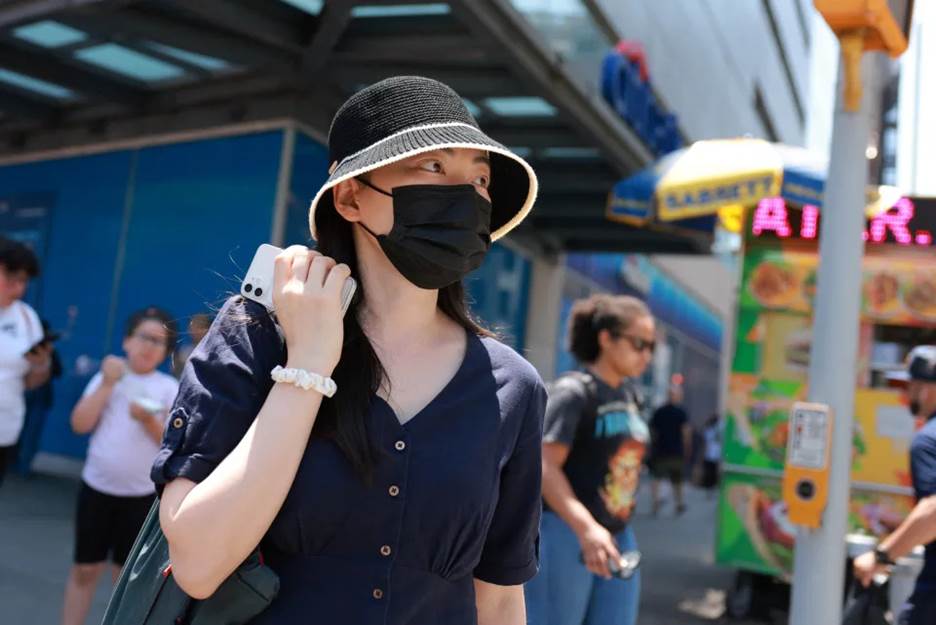
A pedestrian in a face mask in New York City on July 6 - Amr Alfiky/Reuters
Coronavirus Is Back, But How Worried Should You Be?
By Alexander Nazaryan

Dr Bob Wachter was an expert who diligently practiced what he preached. For three years, the prominent University of California at San Francisco physician advocated masking and vaccination for those who, like him, wanted to avoid the coronavirus, as well as t he mysterious, long-lasting symptoms known as long COVID .
When Wachter’s wife contracted the coronavirus last year when they were on a trip to Palm Springs, California , together, he still managed not to get sick — even after they sat next to each other in the car on the nine-hour trip back home.
But Wachter’s luck ran out earlier this month, when he finally contracted the coronavirus . To make matters worse, he fell in the bathroom while battling flulike symptoms and was hospitalized for stitches.
Wachter wrote on Twitter that he wanted his experience to serve as a “teachable moment,” a reminder that “Covid’s still around [and] it can still be pretty nasty.”
Not only is the coronavirus still around, but it appears to be returning in parts of the United States.
A summer mini-spike
Washington was not especially rattled by the infections, but the cases are a reminder that the virus lingers. Students competing in the Solar Car Challenge in Orange County, California, for instance, saw the race disrupted this month after about two dozen competitors tested positive for COVID-19 .
When the president of Israel, Isaac Herzog, visited the White House earlier this month, several members of his delegation tested positive for COVID-19 . In North Carolina, Gov Roy Cooper also caught the coronavirus this month . These do not appear to be isolated incidents.
Wastewater analysis in the San Francisco Bay Area, where Wachter lives, shows increasing levels of the coronavirus. Los Angeles is seeing a similar trend .
"There's no doubt compared to our nadirs, or the stability that we've enjoyed, that there's a slight increase in test positivity,” California's health secretary, Dr Mark Ghaly , told the Los Angeles Times this week.
While most people aren’t locking down or sending kids home from summer camp, the virus appears to be causing a vibe shift. “The US has experienced increases in COVID-19 during the past three summers, so it’s not surprising to see an uptick,” CDC spokeswoman Kathleen Conley told Yahoo News.
In previous coronavirus waves, colder weather drove people indoors and allowed the pathogen to spread. Extremely hot weather could have the same effect. “We are in a very warm year, and people are spending a lot of time indoors,” infectious disease expert Dr Luis Ostrosky told the Wall Street Journal. “People are congregating in air-conditioned settings, and that is providing an opportunity for transmission.”
Most institutions that had reported coronavirus cases with online trackers are no longer producing daily updates, making both local and national trends difficult to spot. For its part, the CDC drastically scaled back its own tracking in May .
'Clearly rising,' but nothing like the past
According to the Centers for Disease Control , COVID-19 hospitalizations rose by 10% in the week of July 15, as compared to the previous week, from 6,444 hospitalizations to 7,109.
“Risk of getting infected is still fairly low, but clearly rising now,” Dr Tatiana Prowell, a Johns Hopkins oncologist, wrote on Twitter. “Be aware.”
Masking continues to be an easy means of protection, especially when traveling or gathering in crowded settings like concert venues or sports arenas. And many people have neglected to update their vaccines, meaning that they lack some protection from the ever-evolving disease. The latest spike could be driven, in part, by an Omicron subvariant known as Arcturus .
According to the CDC, only 17% of the American population has received the bivalent booster introduced last fall .
“At this time, CDC's genomic surveillance indicates that the increase in infections is caused by strains closely related to the Omicron strains that have been circulating since early 2022,” CDC’s Conley told Yahoo News.
Those are the very strains the bivalent booster was created to target. The Food and Drug Administration is also preparing an updated booster shot that should be available in September.
Moving on
During the Delta spike in the summer of 2021, nationwide hospitalizations for COVID-19 topped 100,000. A year later, the Omicron wave hospitalized 16,000 people across the country.
Today’s figures are much smaller by comparison. And as of the week of July 22, there had been 166 deaths from COVID-19 across the United States — a far cry from the 26,000 weekly deaths recorded in the US in the first week of 2021.
Those at high risk for severe outcomes should make sure they're up to date on boosters and know where to access treatment if they contract the virus, Dr Leana Wen, a professor at George Washington University's Milken Institute School of Public Health, told Yahoo News.
Between vaccination and multiple infections, the overwhelming majority of Americans have some immunity. Many have thus simply accepted the coronavirus as a part of life.
"The pandemic, for all intents and purposes, now is gone,” Donald Yealy, chief medical officer of the University of Pittsburgh Medical Center, told the Washington Post several weeks ago .
But, he cautioned, “the virus isn’t gone yet.” –
Yahoo

